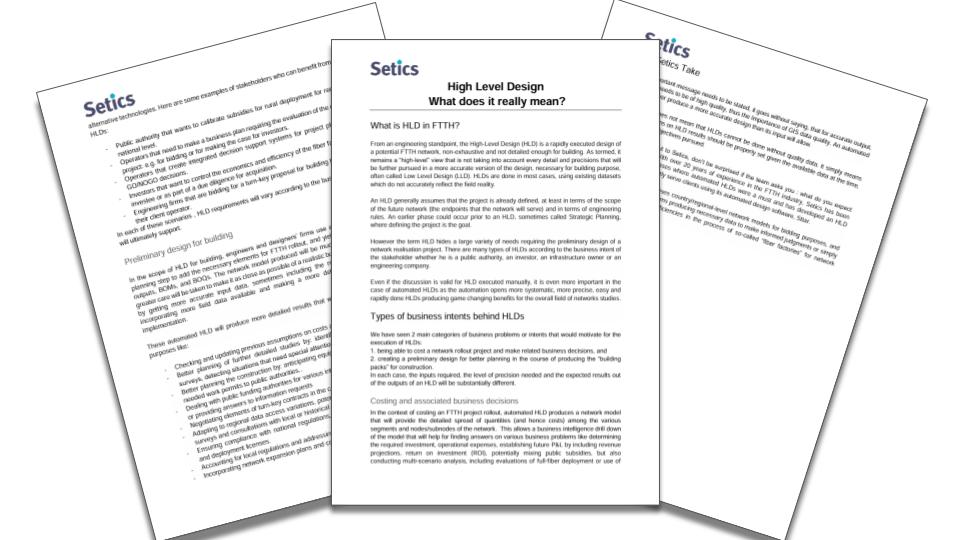In FTTH networks, high-level design (HLD) refers to an initial, non-detailed blueprint that outlines the scope and feasibility of a potential network deployment.
HLDs are used as a strategic tool that is used to assess project viability, estimate costs, and determine the network's coverage, but they also provide a broad overview, facilitating decision-making processes for stakeholders, such as investors, operators, and government entities. Decision-making challenges are one type of business problems HLD help to solve.
The other important business problems are around speeding and planning the design for building of the network. There, while not exhaustive, HLDs lay the groundwork for more detailed low-level designs (LLDs), providing a foundation for future planning.
But, at a time where cost and efficiency have become two of the most important factors when it comes to deploying a fibre network, many stakeholders are missing out on the opportunities that HLDs could provide in overcoming these two key business challenges.
Alain Meller, Partner and Business Development at Setics explains: “One of the main business problems is what happens when the decision is taken to build a network? Questions such as what project will be done; what could the cost be; what is the scope of the network in terms of reaching distant premises; and what could be the profit and loss potential? What is the best solution to combine my commercial builds with areas that are subsidised by the government? That’s particularly interesting when submitting an answer to a government request for proposal (RFP), for example, like in the UK.”
Faster and more efficient FTTH network rollout
The second big challenge is achieving faster and more efficient network rollout. Says Meller: “A problem that needs to be solved is how to speed up the rollout on the network as a first thing, so, having the ability to do the studies in a quicker and more efficient manner.”
By automating the HLD process, stakeholders involved in the deployment of FTTH networks could take advantage of the opportunities provided in helping to solve these business problems, as opposed to seeing them as just another necessary step in the process. They can leverage its capabilities to estimate the cost of a network investment by providing multi scenario analysis and reports for decision making, or even preparing bills of materials and quantities.
Meller understands the potential for HLDs only too well, as during its 20+ years in the FTTH industry, Setics has seen many customers who benefitted from automated HLDs. The company developed an HLD service framework, comprising not only the Setics Sttar Advanced Designer that automates the network model creation, but also the input data engineering piece as well as the generation of insights and documents from Sttar results to build a complete solution that addresses the business problem.
Meller says: “Setics Sttar is a very powerful system that generates network models, which are the root for answering those business problems. Because you need to have a model. Sometimes very detailed, sometimes less detailed, but having a flexible way to generate models is the underlying piece that is needed. However, this is not the only piece to get an answer to the problem: data engineering and insights/documents elaboration out of the generated model are equally important as well as obtaining a complete streamlined process.”
A flexible solution for optical network planning
Because the way to handle and solve business problems vary between countries and operators, having a flexible solution is instrumental to address any network type in most geographical markets. Says Meller: “it is very versatile, and so, able to address the different architectures used in different countries, or even in the same country. For example, in the UK, not everybody deals with the same architecture.”
The level of detail will also vary, depending on the business problem, explains Meller: “If you want to address speeding up the rollout of the network, you have to have in mind to create a very detailed model that will be as close as possible to the final design to build. This raises the bar to get quality data as input, and hence, in most cases use field survey data to achieve that. Although challenging, in most cases, it can be done in a pretty much completely automated way.”
On the other hand, with the decision making problem, says Meller: “We don't need to address all the details to create a useful network model to solve problems like costing. An example would be that you don't necessarily need to know all the detailed prices about every piece on your network, in some cases you can just aim to produce a model that will account for elements that are significantly structuring the cost and drop the less important details. This is an exercise not obvious for engineers that sometimes want to pay attention to every detail and lose the sense of the business goal pursued. But we are also talking about data engineering in connection with extracting and providing the level of precision and quality in line with the required answer to the business problem.”
Case study: Lit Fibre
Setics’ expertise in helping with HLDs has been instrumental in advancing full-fibre internet connections in close collaboration with operators, investors, and service providers. Lit Fibre, a provider of FTTH solutions in the UK in towns and small cities, was looking for a scalable solution to expand its network while ensuring cost-effectiveness and quality. Setics Sttar was able to address these challenges by automating data preprocessing, categorising physical infrastructure access (PIA) ducts, and creating a streamlined design process.
The software's flexibility allowed for efficient design modifications and accurate bill of quantity generation, significantly enhancing Lit Fibre's network design strategy. And the adaptability of the software enabled efficient design modifications directly on the map interface, providing comprehensive solutions that cater to varying geographical areas. With Setics Sttar's support, Lit Fibre aims to connect 500k homes with high-quality full-fibre internet by 2026.
The work with Lit Fibre serves to demonstrate Setics’ philosophy that, rather than provide the software alone, the company is a key resource for FTTH stakeholders, with 20 years of experience in the market from which to draw. Meller explains: “We are not just selling a piece of technology, we also help customers to address these business issues, and we're more than happy to do that. That could be us, or it could be via one of our partners.”
Case study: GreySky Consulting
One example is GreySky Consulting in the UK, which provides strategic support to business and public sector clients, and has developed expertise in supporting independent network operators. The company started using Setics Sttar in 2019 to support their operator clients’ funding bids. Funding applications in Scotland and Northern Ireland in particular demanded detailed plans to support applications before a contract could be signed. One particular project required a detailed HLD for a large area of Scotland in just six weeks. Setics Sttar allowed the consultants to evaluate various scenarios with different configurations to find the best approach for each situation.
James Saunby, Consulting Director at GreySky Consulting says: “Effective high-level design is a critical stage in ensuring the most beneficial deployment of capital for commercial return. We have found Setics Sttar to be the deciding factor in delivering that benefit. It was essential that I had expert support to ensure I could always deliver my clients’ expectations. The technical support you get from Setics is exceptional!”
Says Meller: “We develop our partnerships with other people and companies that are also solution-oriented. They can benefit from using our tool, and also our expertise, where required, because we can provide people that are knowledgeable about the business of an operator. Not only the cost, but also the business side of it.”

Setics has produced a White Paper that provides more detail on how FTTH stakeholders can leverage the benefits of HLDs to overcome key business challenges, and how Setics’ advanced solution and expertise can support them.


